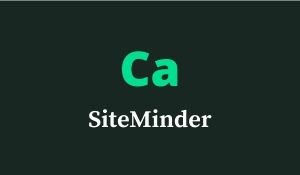
SITEMINDER IN BRIEF
SiteMinder is an Access Management component. It offers a centralized and secure policy administration on a large scale. It offers a way to authenticate users and authorize the user for the application which he is only permitted for. Its authorization model is primarily based on security policy. Its features consist of user authentication and single sign-on, policy-based authorization, and identification federation. One of the first single sign-on products to arrive on the market, legacy SiteMinder installations still exist to protect enterprise applications in many company networks.
The Web Application Firewall might also integrate with SiteMinder to provide single sign-On and centralized management of web applications the use of the predefined security policies. It uniquely identifies a user before he/she is authenticated as a named user, and manages user’s privileges to ensure that the user access only authorized functions or operations. In SiteMinder single sign-on (SSO), a user efficiently authenticates through one agent and does not want to re-authenticate when accessing a realm protected through a different agent. The two agents ought to be in the same cookie domain.

Siteminder works, if the resource is no longer protected then Web Agent permits the web site or app to proceed and return the requested web page to the user. If a resource is protected and the user is not authenticated then the web app returns an Access Denied error. If a resource is protected and the user is not authorized then the web app returns an Access Denied error.
WHY ACCESS MANAGEMENT?
Regardless of how a user accesses an application, the first step is the access management procedure is authentication, which permits the user to exactly identify them. Therefore, the first critical capability of a modern access management technology is to be able to help any and all methods of authentication, and more importantly, be capable of managing when each one is used to challenge a user.
Once authenticated, the subsequent critical functionality is to manage and protect the user’s session. This capability unifies the user experience throughout multiple applications while concurrently delivering single sign-on, however additionally ensuring that the user’s session is protected against hijacking. Additionally, as the user requests access to applications, the access management technology should be capable of performing authorization checks to determine whether the user has to be granted access. A modern access management technology can provide these capabilities, both for modern applications, modern protocols, and modern architectures, as well as for legacy web applications.

Limitations of Siteminder
- When a user logs into a computer and authentication is handled by the operating system, then you cannot pass user information to SiteMinder because SiteMinder was designed to work in a web server environment, where authentication is triggered upon a URL request.
- Though SiteMinder is a valuable tool for SSO (Single Sign-On) login between disparate web applications, the user is still required to log into the platform from which the web applications will be launched. SiteMinder also requires that an agent be installed on each web server that will participate in the SSO environment.
SITEMINDER NEW ADVANCEMENTS AND ITS OPPORTUNITIES
The new SiteMinder Plug-Ins for the Modernize IAM Accelerators can help in the following areas:
- Authenticate in SiteMinder and single sign-on (SSO) to ForgeRock
- Authenticate in ForgeRock and SSO to SiteMinder
- SSO to legacy apps integrated via CA agents
- Migration of user profiles
- Secure migration of user passwords
- Just-in-time (JIT) provisioning
- Modular and extensible for easier integration into current environments
- Open source so it relies on industry standard protocols and libraries
SiteMinder Plug-Ins are designed to help make migration seamless and invisible to the user, while having a significant impact in time to value around the design and build of coexistence and user migration strategies.
According to research CA SiteMinder has a market share of about 2.5%. Due to the high demand for CA SiteMinder, there are numerous job opportunities available around the world. Many top organizations have started using CA SiteMinder in their deployments increasing job possibilities in this field.CA SiteMinder professionals are earning greater salaries compared to professionals working on other technologies. The average salary of a CA SiteMinder professional is $133,118 USD per annum. World’s top multinational organizations are recruiting CA SiteMinder certified professionals. Gologica’s CA SiteMinder online training will assist you to enhance the skills and knowledge required for efficient control over web applications through installing and configuring CA SiteMinder by industry experts who have hands-on experience.










